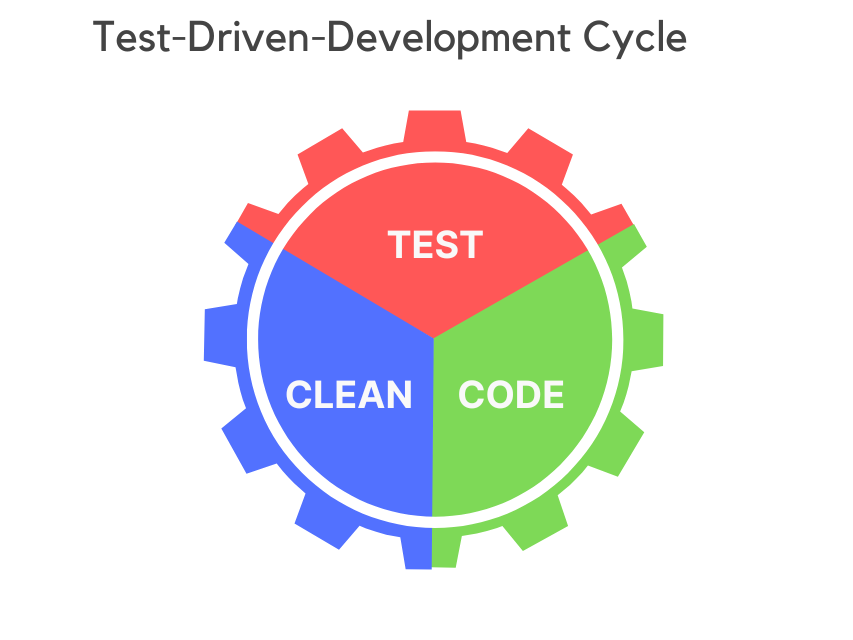Test-Driven Development (TDD) is a software development methodology that has gained popularity in recent years. Rooted in Extreme Programming (XP – see extremeprogramming.org), it’s an integral part of agile software development. TDD not only enhances software quality and reliability but also improves maintainability and scalability of the code. It also assists developers in focusing on requirements and functionalities.
The Three Phases of TDD
Following a simple cycle, Test-Driven-Development is divided into three phases:
- Red Phase: the developer writes a test describing the desired functionality. This test will fail since the corresponding code has not yet been implemented. This approach helps to focus on the requirements and ensures that the desired functionality is clearly defined.
- Green Phase: the developer writes the bare minimum of code to pass the test. The goal is to get the test to pass, demonstrating that the desired functionality has been implemented correctly.
- Refactor Phase: the developer improves the code while maintaining functionality to archive a clean, readable, and maintainable code. This phase is crucial for ensuring that the code remains testable and that the software is developed incrementally in small, manageable parts.

The Benefits of TDD for Businesses
TDD offers numerous benefits for businesses of all sizes. For startups, it enables a sustainable product development. By writing tests first, developers have a clear understanding of the desired functionality, which helps in designing and implementing the code. TDD also encourages the development of small, testable units of code, which can be easily integrated into the overall system.
For larger companies, TDD contributes to improved code quality and reduced long-term maintenance costs. This reduces the likelihood of introducing bugs and errors into the system.
Additionally, the tests serve as a living documentation of the code, providing a clear understanding of the expected behavior. This improves the maintainability of the codebase, as developers can easily identify and fix issues without introducing new bugs.
TDD also enhances software quality and reliability. By writing tests first, developers are forced to think about potential edge cases and error scenarios. This leads to more robust and resilient code. The tests act as a safety net, catching regressions and preventing the introduction of new bugs. Automated testing, which is an integral part of Test-Driven-Development, allows for frequent and efficient testing of the codebase, ensuring that the software remains stable and performs as expected.
Another advantage of this approach is better coverage of the acceptance criteria of a user story in a sprint. Basically, unit tests reflect the functional requirements included in a story. Developing code matching these tests helps to stick to the requirements. A developer can easily say if all mentioned requirements are covered just by looking into the tests.
What They Don’t Tell You About TDD
Even though test-driven development is a great approach to improving code quality, it is not a silver bullet. There are a few things to consider before introducing TDD into your development process.
The development of new features takes longer. Writing tests also takes time. This must also be taken into account when estimating the effort required to meet the sprint goal at the end of the sprint.
Furthermore, most tests only cover partial aspects. As the aim of TDD is to alternate between writing tests and code, unit tests are written in the vast majority of cases. However, these do not cover complete processes. Automated end-to-end tests or manual tests must be carried out before an user story can be approved.
Moreover, bug fixing or refactoring can become tedious. One of the biggest advantages of TDD (the creation of many tests and high test coverage) can also become a disadvantage. If code is adapted in the course of refactoring or bug fixing, this can lead to some tests having to be adapted as well. This takes time and the developer must understand what the tests are supposed to check.
Conclusion
Test-Driven-Development is one of many ways to ensure and improve your code quality. Following the three phases to develop the test, the code to fulfill the test and to refactor the code after it works is a good process to ensure consistency and a high test coverage. However, the negative aspects of TDD also have to be considered. If the priority is to deliver a prototype that will be thrown away afterwards, think twice before spending time in developing tests.
You want to implement your next project following the TDD approach, but you don’t know how to start? Visit my TDD service page for more information or

